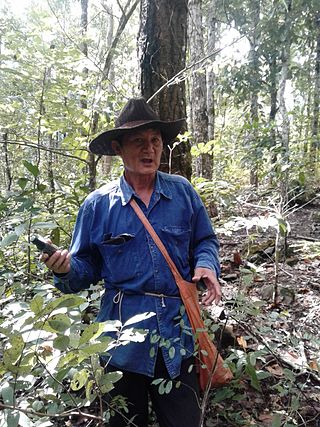
Agritourism or agrotourism involves any agriculturally based operation or activity that brings visitors to a farm or ranch. It encompasses a wide range of activities, including direct-to-consumer sales such as farm stands and u-pick, agricultural education through school visits, hospitality services like overnight farm stays, recreational activities such as hunting and horseback riding, and entertainment events like hayrides and harvest dinners. These activities provide an additional source of income for farmers and help sustain small-scale farms.

Ecotourism is a form of nature-oriented tourism intended to contribute to the conservation of the natural environment, generally defined as being minimally impactful, and including providing both contributions to conservation and environmental education. The definition sometimes also includes being financially beneficial to the host community or making conservation financially possible. There are a range of different definitions, and the correct definition of the term was an active subject of debate as of 2009. The term is also used more widely by many organizations offering nature tourism, which do not focus on being beneficial to the environment.

In general, a rural area or a countryside is a geographic area that is located outside towns and cities. Typical rural areas have a low population density and small settlements. Agricultural areas and areas with forestry are typically described as rural, as well as other areas lacking substantial development. Different countries have varying definitions of rural for statistical and administrative purposes.
Community-based economics or community economics is an economic system that encourages local substitution. It is similar to the lifeways of those practicing voluntary simplicity, including traditional Mennonite, Amish, and modern eco-village communities. It is also a subject in urban economics, related to moral purchasing and local purchasing.

Komodo National Park is a national park in Indonesia located within the Lesser Sunda Islands in the border region between the provinces of East Nusa Tenggara and West Nusa Tenggara. The park includes the three larger islands Komodo, Padar and Rinca, and 26 smaller ones, with a total area of 1,733 km2. The national park was founded in 1980 to protect the Komodo dragon, the world's largest lizard. Later it was dedicated to protecting other species, including marine species. In 1991 the national park was declared a UNESCO World Heritage Site and a Man and Biosphere Reserve. It is considered one of the world's 25 biodiversity hotspots.

Sustainable tourism is a concept that covers the complete tourism experience, including concern for economic, social, and environmental issues as well as attention to improving tourists' experiences and addressing the needs of host communities. Sustainable tourism should embrace concerns for environmental protection, social equity, and the quality of life, cultural diversity, and a dynamic, viable economy delivering jobs and prosperity for all. It has its roots in sustainable development and there can be some confusion as to what "sustainable tourism" means. There is now broad consensus that tourism should be sustainable. In fact, all forms of tourism have the potential to be sustainable if planned, developed and managed properly. Tourist development organizations are promoting sustainable tourism practices in order to mitigate negative effects caused by the growing impact of tourism, for example its environmental impacts.

Muang Xay, also referred to as Oudomxai or Oudomxay, is the capital city of Oudomxai Province, Laos.

Namibia is one of few countries in the world to specifically address habitat conservation and protection of natural resources in their constitution. Article 95 states, "The State shall actively promote and maintain the welfare of the people by adopting international policies aimed at the following: maintenance of ecosystems, essential ecological processes, and biological diversity of Namibia, and utilization of living natural resources on a sustainable basis for the benefit of all Namibians, both present and future.".

Rural tourism is a form of tourism that focuses on actively participating in a rural lifestyle. It can be a variant of ecotourism, emphasizing sustainable practices and community involvement. Many villages can facilitate tourism because of the hospitality and eagerness of villagers to welcome or host visitors. The mechanization of agriculture has reduced the need for manual labor, leading to economic pressures on some villages and prompting young people to migrate to urban areas. However, a segment of the urban population is increasingly interested in visiting rural areas to experience and understand the rural lifestyle.

Botswana's principal tourist attractions are its game reserves, with hunting and photographic safaris available. Other attractions include the Okavango Delta region, which during the rainy season is a maze of waterways, islands, and lakes. The tourism industry also helped to diversify Botswana's economy from traditional sources such as diamonds and beef and created 23,000 jobs in 2005.

Rural economics is the study of rural economies. Rural economies include both agricultural and non-agricultural industries, so rural economics has broader concerns than agricultural economics which focus more on food systems. Rural development and finance attempt to solve larger challenges within rural economics. These economic issues are often connected to the migration from rural areas due to lack of economic activities and rural poverty. Some interventions have been very successful in some parts of the world, with rural electrification and rural tourism providing anchors for transforming economies in some rural areas. These challenges often create rural-urban income disparities.
Nai Soi is a small village located in Mae Hong Son Province in northern Thailand. The village is under the administration of the Thai authorities. Nai Soi is about three kilometers from the Ban Mai Nai Soi Karenni refugee camp. Nai Soi is about 20 kilometers from the town of Mae Hong Son, along a paved road accessible year-round. It is perhaps most well known for the refugee camp found there and for having the largest Karenni settlement of the three villages. Thai authorities view Ban Mai Nai Soi as a self-sustaining refugee camp.

Community forestry is a participatory model of forestry that gained prominence in the 1970s in which local communities take an active role in forest management and land use decision making. Community forestry is defined by the Food and Agricultural Organization of the United Nations as "any situation that intimately involves local people in forestry activity". Unlike centralized management systems, community forestry more strongly emphasizes the participation and collaboration of local community stakeholders, along with government and non-governmental organizations (NGOs). The level of involvement of each of these groups is dependent on the specific community forest project, the management system and the region.
Responsible tourism is a relatively modern concept in the Kingdom of Thailand that took root in the late-1990s. It is underpinned by the belief that tourism should develop in a manner that minimizes negative impacts on local communities, and wherever possible ensure that a positive symbiosis exists between hosts and visitors. Responsible travel promotes a respect for indigenous culture, the minimization of the negative environmental impacts of tourism, active participation in volunteering to assist local communities, and the structuring of businesses to benefit the final service provider rather than an international agent.
Community-driven development (CDD) is an initiative in the field of development that provides control of the development process, resources and decision making authority directly to groups in the community. The underlying assumption of CDD projects are that communities are the best judges of how their lives and livelihoods can be improved and, if provided with adequate resources and information, they can organize themselves to provide for their immediate needs. CDD projects work by providing poor communities with direct funding for development with the communities then deciding how to spend the money. Lastly, the community plans and builds the project and takes responsibility for monitoring its progress.
The Mae Fah Luang Foundation (MFLF) is a private, non‐profit organization established to improve the quality of life of people in poverty and deprived of opportunities. It manages numerous projects in Thailand as well as other countries in Asia. The foundation's mission focuses on three main areas: “improving social and economic development, preserving the environment, and supporting local art and culture.”

Ethnic villages are a basic administrative district within China designated for minority ethnic groups. The villages are designated by the government within geographical regions where minority groups live. The approval and establishment of a village is most often the responsibility of provincial governments and prefectural governments, however villages are often established with different requirement standards. According to a local ordinance regarding the protection of interests relating to minority group villages, a meeting is held where 30% of participants belong to a minority group; if the local government approves of the formation of the new establishment, the region is designated an ethnic village. In Hubei province, villages where minorities account for 50% of the population are designated as minority group villages.

Ban Thapene is a village of Luang Prabang District, Luang Prabang Province, Laos. The village was first established about 130 years ago by Kha Hok families, one of the Khmu ethnic sub-groups. Like many other upland inhabitants in Luang Prabang, the livelihood and culture of ethnic groups such as Lao Loum, Kha Hok, Yao and Hmong in Ban Thapene is dependent on natural resources.
Tourism has been an ever-growing industry in the Kodagu district of India. The impacts of tourism in Kodagu district effect the country's economy, environment, and culture. The impacts can be positive and negative. Ecotourism and homestays have been adopted to provide stable household income, and promote environmental awareness and cultural experiences to foreign travellers. Economic impacts include overall income increasing from employment but jobs were usually seasonal. Environmental impacts like funding from tourism would support conservation efforts and natural resource management but would bring pollution and biodiversity degradation to the district. Sociocultural impacts where residents of Kodagu like having tourists but risk losing access to resources. Kodagu district is commonly known as the "Scotland of India". The district is a hotspot for tourism and recreational activities. The mountainous Kodagu region is filled with biologically diverse tourist attractions such as waterfalls, forests, and wildlife which can be impacted by tourism.

Waerebo or Wae Rebo is a village situated in the Manggarai Regency, East Nusa Tenggara. Located at 1,200 meters above sea level, the village is composed of 7 main houses, known as mbaru niang. In 2012, it was given Cultural Heritage Conservation status by UNESCO Asia Pacific. It is one of the cultural tourism destinations in Manggarai Regency, Indonesia.















